In an aquarium, you can classify your fish based on the zones where they spend their time the most. Generally, there are surface feeders, mid-water dwellers, and bottom feeders.
The surface and mid-water swimmers may be gorgeous to display, but they don’t help you maintain a clean aquarium. The ones that do that are bottom dwellers!
Many bottom feeder fish species devour uneaten foods, excessive algae, and other waste all over the tank. As natural cleaners, they help to keep the oxygen level high and promote a healthy environment for every tank’s inhabitants.
The bottom feeder fish are interesting creatures. So if you’re thinking about what bottom feeders you want to get, keep reading. We will provide you some recommendations that may suit your need and liking.
Table of Contents
What Is Bottom Feeder Fish?
Bottom feeder fish is a fish that feed on the bottom layer of the water. They like to swim close to the substrate and bury themselves in it. There they also scavenge for food! They can also be seen eating dead organic matter (plant and animal) on the bottom. For this, some of them are called detritivores.
Bottom feeder fish are found in both fresh and saltwater and are not only limited to fish species. Other species like starfish, snails, crayfish, shrimps, and crabs can also be considered bottom feeders.
Some bottom feeders, however, do not exclusively get their food on the water base. Some catfish may swim across different parts of the aquarium and feed on the middle or surface part.
Characteristics
Most bottom feeders have different characteristics than surface or mid-water dwellers. If you are aware of them, you can immediately tell that those fish are bottom-dwellers. The traits they have serve different purposes. You can find out the details below.
Lower Mouth Position
One trait that makes bottom feeders distinct from other fish species is their mouths. It is located more on the lower side of the fish’s body and is commonly called a suckermouth.
It is round and looks like a suction cup. You may have seen some strange-looking fish latching their mouth onto the aquarium glass. Yes, that’s a bottom feeder with the suckermouth.
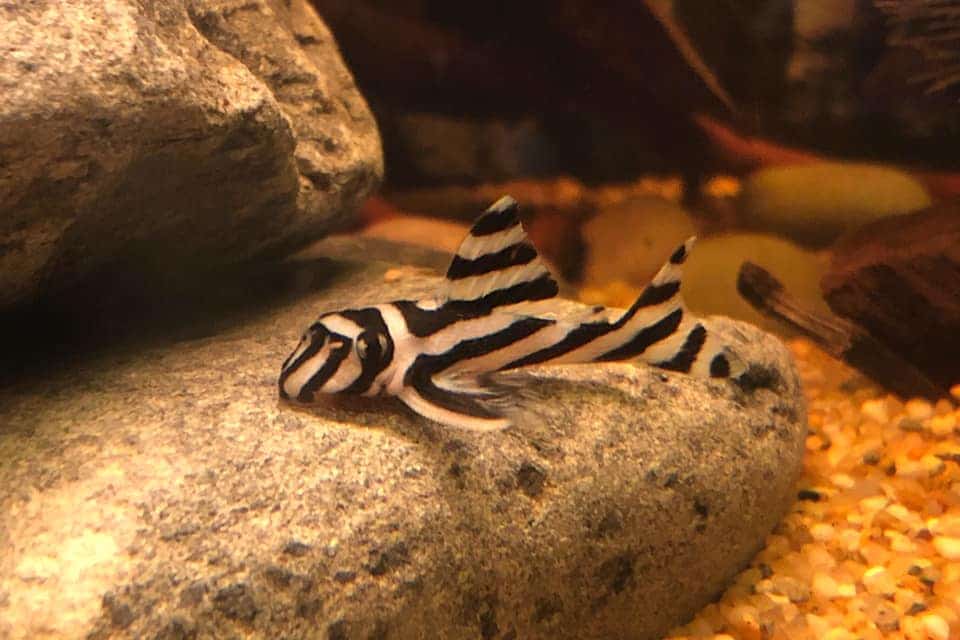
Suckermouth has various functions rather than just looking unique. First, it helps them to stick onto a surface if they are in waters with fast currents. In nature, they will most likely hold onto a rock, log, or substrate.
Second, the suckermouth is convenient for the bottom dwellers to scavenge food on the substrate. Sometimes there are food sources that are unreachable for many fish. But for fish with suckermouth, it can be easily sucked and extracted from the surface.
In addition, the mouth location helps the fish to keep feeding on the substrate while watching their surroundings. In case some predators are preying on them, they will quickly notice.
Barbels (Whiskers)
Barbels are tiny appendages that grow near or around the fish’s mouth. The fleshy whiskers serve several functions for the fish.
For one, it helps them sense and even tastes the food near them. The small barbels have tasting cells that make them act almost like a tongue. This makes them rarely miss any feeding opportunity.
Next, the whiskers help fish that lives in poor visibility areas to see their environment. It acts as the navigator of the fish. One species that benefit from this function is Tiger Shovelnose Catfish since they live in deep waters in the wild.
Flat Bellies
This feature goes well with the suckermouth that’s on the bottom of the fish. Besides, it completely makes sense.
Since the bottom feeder fish (and non fish) spend their time sliding on the water base or other flat surfaces, their flat bellies make them comfortable doing all that.
It helps them easily catch all food they can find on the bottom while staying low on the substrate. After all, that’s why they are called bottom feeders.
8 Bottom Feeder Fish (and non-fish) Recommendation For You
After learning about what bottom feeders are and their unique traits, we have here some best bottom-feeders of our pick. A few of them may not be suitable for everyone, but who knows if they fit your requirement perfectly.
Kuhli Loach
Minimum Tank Size: 20 gallons
Diet: Omnivorous. Will take flakes, pellets, and live foods such as bloodworms, shrimps, and daphnia
Lifespan: up to 10 years
Care Level: Easy
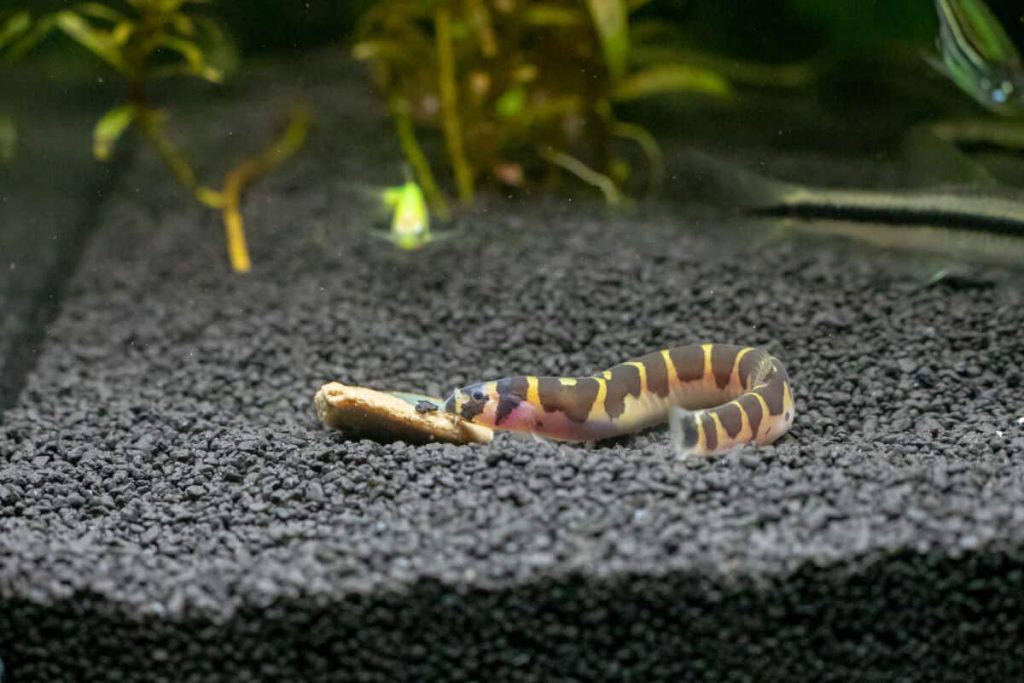
This one on the list is most likely to be recommended to anyone looking for a bottom dweller. They are easy to care for, making them suitable for beginner and advanced aquarists.
Kuhli Loach (Pangio kuhlii) is a unique fish that looks like an eel or a snake. They have a long, slender body with brown bands or yellow stripes that covers their whole skin. As for the size, the Kuhli Loach can grow around 4 to 5 inches long.
Another good character is they are extremely peaceful and can be housed with much other calm fish. Semi-aggressive and aggressive fish will most likely intimidate them, so avoid keeping them together with such species. It’s also better to house the Kuhli Loach in a school of 5 or 6. If they’re kept alone, you will barely see them as they will spend their time only for hiding.
The eel-like fish is pretty delicate. Smooth-surfaced decorations and soft sandy substrate will suit them best, as they love to filter the sand. They also appreciate heavily planted tanks since they like some shady places to hide during the day as they are nocturnal.
Bristlenose Pleco
Minimum Tank Size: 20 gallons
Diet: Herbivorous. You can feed them algae wafers and many kinds of veggies including cucumber, carrot, pea, cabbage, spinach, and lettuce
Lifespan: up to 12 years
Care Level: Easy

Just like the Kuhli Loach, the Bristlenose Pleco (Ancistrus) is also one of the most sought bottom dwellers. Although some people dislike them for their appearance, they have great qualities that outdo the look.
This bottom feeder fish is tough and low maintenance, which will suit all hobbyists and aquarists. They can tolerate various water conditions and have a peaceful temperament. It makes them compatible with many types of fish, even the semi-aggressive ones (but small).
Most of the time, you can find them swimming along the substrate while sucking and sweeping. If not, you can probably see them attached to the aquarium glass or hide away somewhere. They are one fun creature to watch.
Another important trait is that the Bristlenose pleco can help clean your tank! They are an excellent algae eater and do the cleaning job during the night since they are nocturnal. They also gladly eat leftover foods and other organic matter.
As for their appearance, they have a rather dull and pale coloration. The Bristlenose usually comes in yellow, olive green, brown, or brown with some light patches. They can reach the size of 3 to 6 inches.
They have tiny whiskers all over their mouth, which actually helps to find the sinking food. It’s also where they acquired their name from.
Zebra Loach
Minimum Tank Size: 20 gallon
Diet: Omnivorous
Lifespan: up to 10 years
Care Level: Easy
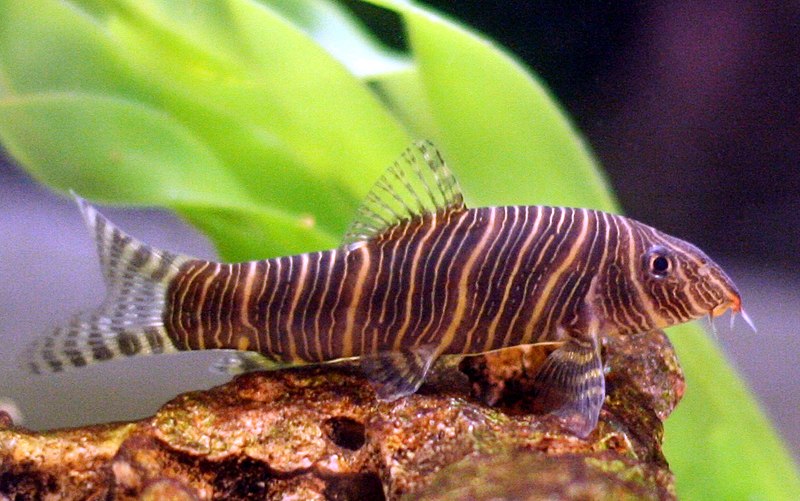
The Zebra Loach (Botia striata) is another beautiful fish that has a unique display. Just like the name suggests, the loach has vertical zebra-like stripes that go throughout its body.
As for the coloration, they usually come in black or brown with a combination of yellow. Their translucent fins also add to their appearance. In general, this bottom dweller can reach the size of 4 inches in adulthood.
Not only do they look pretty, but the Zebra Loach also comes with other great qualities. Like many other bottom feeders, they love to search for food in the substrate and glass. This means they like doing the dirty job to help you keep a clean tank environment.
They do the cleaning by snacking on algae, fallen plants, detritus, and even some wild snails. But to keep their diet balanced, you can feed them varieties of food. You may give them sinking pellets, as well as live foods like daphnia, brine shrimp, and bloodworms.
This loach can make an excellent addition to the community tank since they are peaceful and will most likely mind their own business. Even so, there are some fish species you need to avoid being kept together with the Zebra Loach.
It’s not recommended to house them with the Cory Catfish, as they will fight each other for territory. Bettas, Guppies, and Angelfish also should not be housed together with the striped loach.
Unlike other loaches, the Zebra loach is not nocturnal. But they do love some plants and hiding places like driftwood or caves since they love playing hide and seek.
Otocinclus
Minimum Tank Size: 20 gallon
Diet: Herbivorous
Lifespan: up to 5 years
Care Level: Moderate
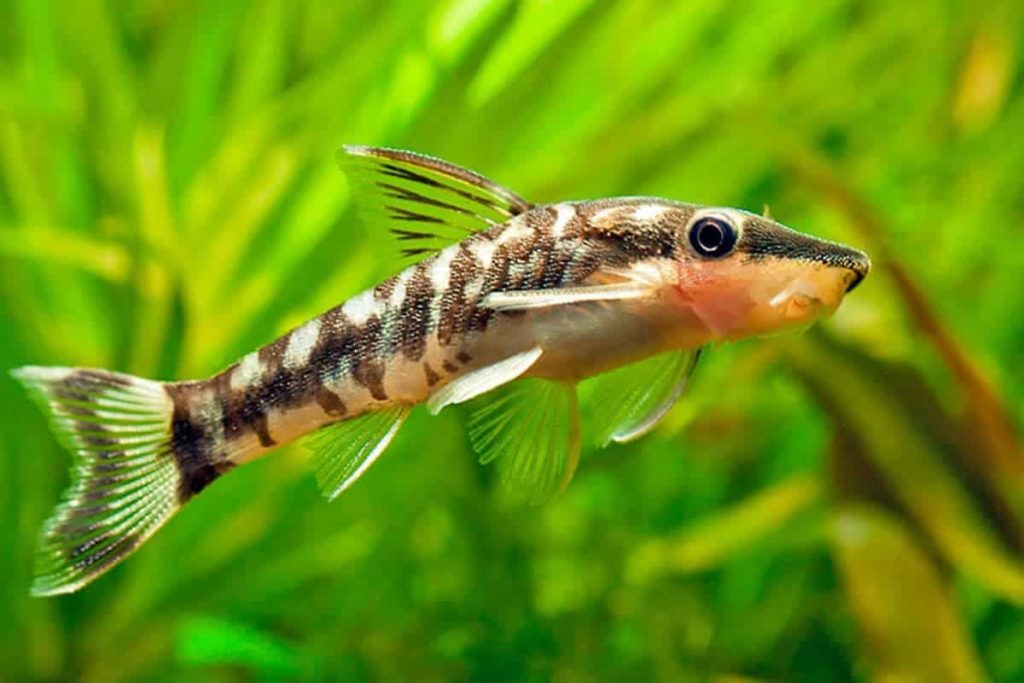
Otocinclus or Oto fish is one of the most famous algae eaters in the aquarium trade. There are at least 17 species from the family, but we will only talk about the dwarf oto (Otoclinus vittatus) since it’s the most common one.
They may not be bright and colorful, but still cute. They have black, gray, and white coloration that usually look like patches. In terms of size, the dwarf oto only grows up to 2 inches.
Although they are small and can fit in a nano tank, this Otocinclus may not be very beginner-friendly. A sudden or drastic fluctuation in the water will cause a terrible shock to them and might have a fatal result.
Other than that, they just require basic things. The tiny bottom-dweller love a highly vegetated aquarium, sandy substrate, and algae wafers as their food. They will also gladly accept various veggies such as zucchini, boiled peas, and spinach.
The dwarf oto is also suitable for a peaceful community tank with other small, calm fish. Some compatible tank mates are Cory Catfish and snails. On the other hand, you need to avoid Cichlids, Goldfish, and Oscars.
It’s also better to house them in a school of 6 minimum. They used to swim together in groups of thousands in their natural habitat.
Siamese Algae Eater
Minimum Tank Size: 20 gallon
Diet: Omnivorous, but prefer vegetable matters
Lifespan: up to 10 years
Care Level: Easy
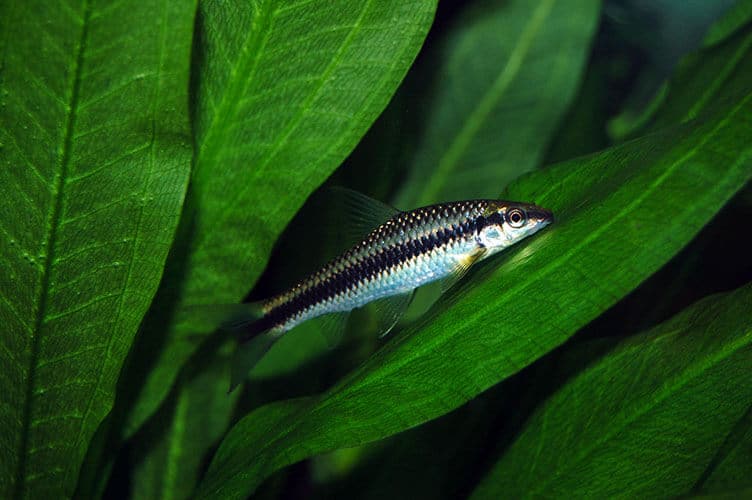
The Siamese Algae Eater (Crossocheilus oblongus) is one fish in the most recommended bottom feeder fish for sure. They have many positive traits that come with them, making the fish suitable for even beginner aquarists.
This bottom-dweller has silver or gold coloration with a long horizontal black stripe that goes along the body. They are long and slender and can grow up to 6 inches when reaching adulthood.
Another quality that makes this fish attractive is they are hardy and easy to care for. They also do the cleaning duty in the tank and even eat black beard algae and insects. To supplement their diet, you can provide them algae wafers or pellets.
It’s not necessary to keep them in shoals. But if you do, you can see the algae eaters hang out with each other and being active. You can also keep them in a community tank with other peaceful species. Many suitable tankmates for the algae eater include Tetras, Guppies, Ghost and Amano shrimp, even bigger ones like Barbs and Gouramis.
To make them even happier, you can place many plants and smoots-surfaced decoration as well as soft substrates in the tank. In their natural habitat, the algae eater lives in densely vegetated areas. Providing them with many hiding places will make them feel at home.
Tiger Shovelnose Catfish
Minimum Tank Size: 250 gallons
Diet: Carnivorous
Lifespan: 18 to 25 years
Care Level: Moderate
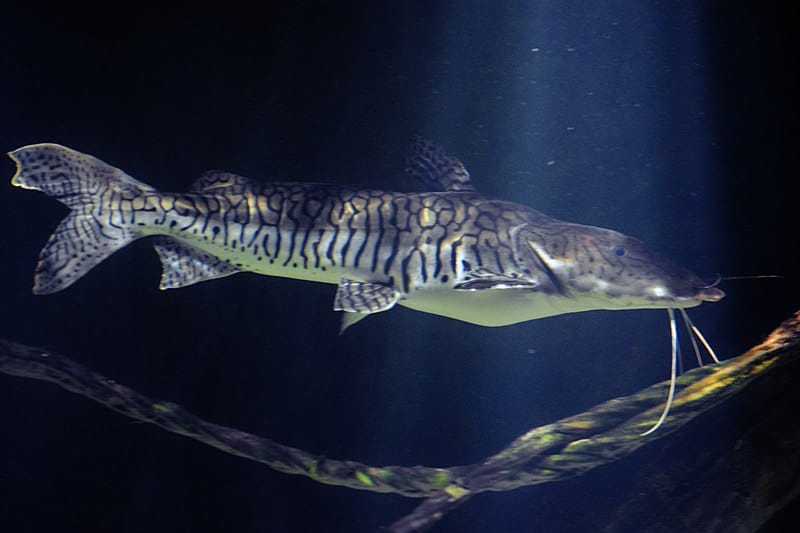
If you are into larger fish, you can consider getting this one. Obviously, due to its size and some other reasons, the Tiger Shovelnose is not for everyone.
In the wild, this bottom feeder can reach the size of 40 inches, which is massive. However, they usually only grow up to 24 inches in captivity. Still, you need to provide a huge tank to give them a good life quality.
Tiger Shovelnose (Pseudoplatystoma fasciatum) looks absolutely gorgeous with platinum coloration and tiger-like stripes along their body. They have long whiskers that help them sense foods near them. That’s because they live in dark deep rivers in nature.
As for their diet, you can feed them pellets, frozen foods, or worms. You can also give them shrimp or fish pieces as a delicious treat and nutritional addition.
One more thing to keep in mind is that this bottom feeder has an aggressive temperament. You need to be careful when choosing tank mates for them. Smaller and peaceful fish will likely be eaten, while larger fish like Arowana or giant Gourami may be a good fit.
Crayfish
Minimum Tank Size: 30 gallon
Diet: Omnivorous
Lifespan: 4 years
Care Level: Easy
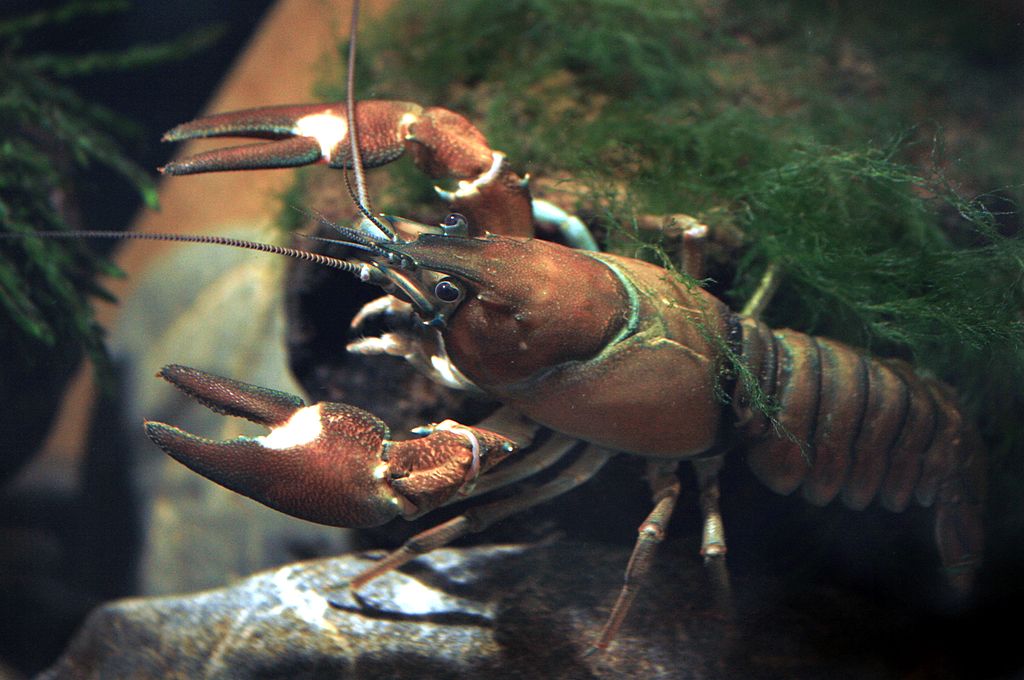
Bottom feeders are not limited only to fish species. The lobster-like critter can also be an excellent bottom dweller in your tank. They are cute and colorful, which makes it really fun to watch them.
Crayfish (Cambarus sp.) come in various colors, such as bright red, purple, yellow, and white. They grow up to 3 inches, but some bigger species can reach the size of 8 inches.
Crayfish always try to be busy and quirky. They move around a lot. Although they may look cute, the critter is actually on the aggressive side. You can’t house them together with smaller and slow-moving fish, or else you will see them gone soon. Also, avoid keeping them with shrimp and snails as you will see a similar result as the previous.
The good news is, crayfish is quite easy to care for and can help you clean the tank. As they walk around, they will continuously munch on leftover food or other organic matter. They even eat dead fish, too! For their daily diet, you can give them algae wafers and brine shrimp.
In addition, you may need to have some holes in the tank for your crayfish’s hiding space. They are crustaceans, so their exoskeleton will shed and be replaced with the new one. In the meantime, they are more fragile and need a safe shelter.
Nerite Snails
Minimum Tank Size: 5 gallon
Diet: Herbivorous
Lifespan: 2 years
Care Level: Easy
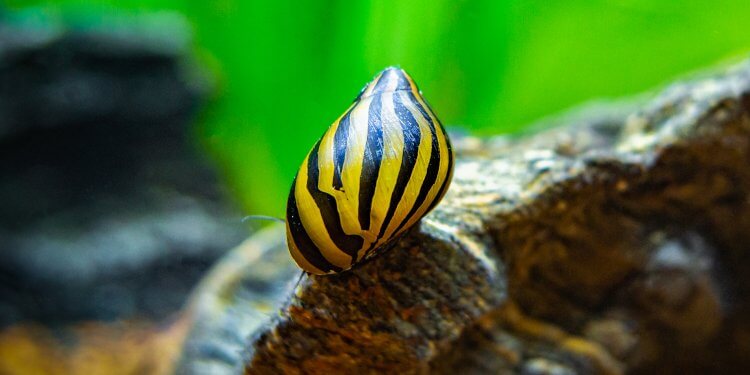
Another non-fish species that many people tend to miss when picking for a bottom dweller. They are, however, cute and useful!
Nerite snails (Neritina sp.) are available in many colors and patterns. This includes plain black, white, zebra pattern, and some even come with horns. In terms of size, they are undoubtedly small. The tiny critter can only grow up to one-inch maximum.
Besides the interesting appearance, they will also help you clean the substrate and the tank’s glass. The snails don’t require much as they feed on the algae and plants in the tank. But you can give them some algae wafers to add some more nutrition.
Due to their small size, you need to keep them in colonies if you wish them to keep your tank clean. And for the same reason, keeping them with bigger fish is not a good option. Even the peaceful ones might mistake them for food.
They are absolutely suitable for a community tank. However, you can only house them with small, peaceful fish that are mostly herbivorous. You need to avoid keeping them with bigger species such as Cichlids, Goldfish, and Crayfish.
Do You Need a Bottom Feeder in Your Tank?
While it is not necessary to nurture bottom feeders in your tank, keeping some will definitely spare you some time cleaning the tank. The bottom feeders are excellent helpers if you aim for a self-sustaining aquarium.
Besides, many of them come with great appearance and are not difficult to care for. There is also a wide range of varieties where you can choose from. It all depends on your personal taste and needs.
If you plan to get one of the bottom-dwellers, it’s better to carry out deeper research on the specific fish type. It will help you find the perfect bottom-dweller for your tank!
Do you have any experience with keeping bottom feeder fish? Please tell us in the comment section! We would love to hear from you.






